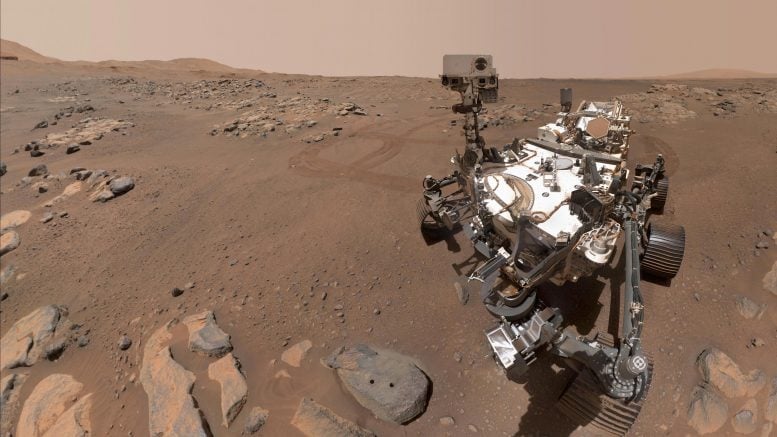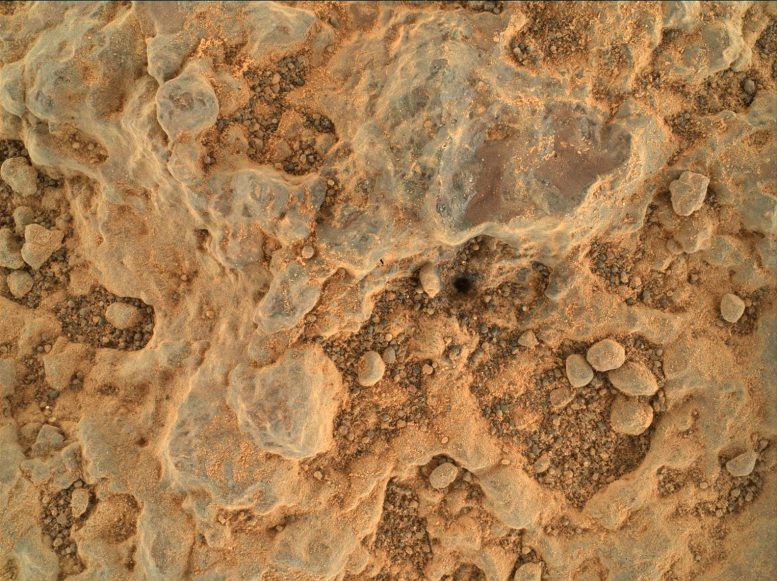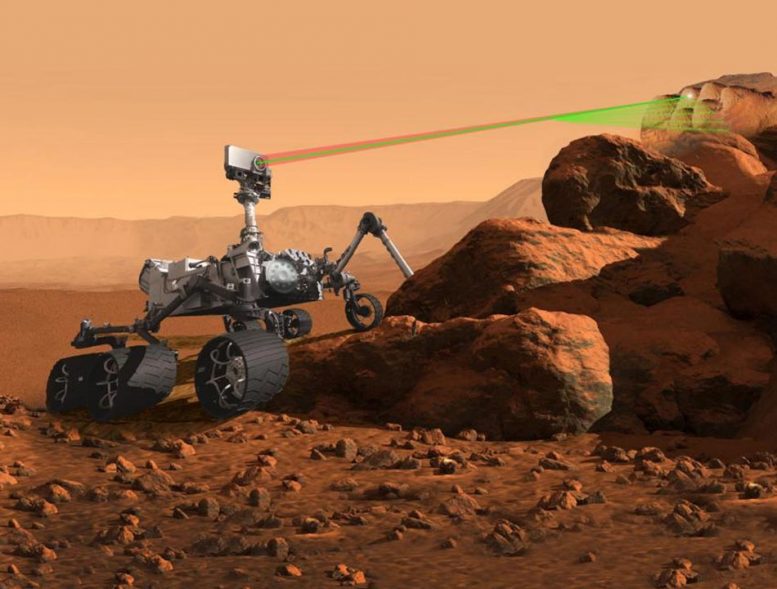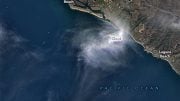
Using its WATSON camera, NASA’s Perseverance Mars rover took this selfie over a rock nicknamed “Rochette,” on September 10, 2021, the 198th Martian day, or sol, of the mission. Two holes can be seen where the rover used its robotic arm to drill rock core samples. Credit: NASA/JPL-Caltech/MSSS
The Mars rover found that Jezero Crater’s floor is made up of volcanic rocks that have interacted with water.
NASA scientists got a big surprise when the Perseverance Mars rover began analyzing rocks on the floor of Jezero Crater in the spring of 2021: They had expected to find sedimentary rock because the crater held a lake billions of years ago. This would have formed when sand and mud settled in a once-watery environment. Instead, they discovered the floor was made of two types of igneous rock – one that formed from volcanic activity at the surface and the other originated from magma deep underground.
The findings are described in four new scientific papers published today, August 25, 2022. In Science, one offers an overview of Perseverance’s investigation of the crater floor before it arrived at Jezero’s ancient river delta in April 2022. A second study in the same journal describes in detail the distinctive rocks that appear to have formed from a thick body of magma. The other two papers, published in Science Advances, document the unique ways that Perseverance’s rock-vaporizing laser and ground-penetrating radar established that igneous rocks cover the crater floor.
Rock of Ages
Igneous rocks make excellent timekeepers. This is because crystals inside them record details about the precise moment they formed.
“One great value of the igneous rocks we collected is that they will tell us about when the lake was present in Jezero. We know it was there more recently than the igneous crater floor rocks formed,” said Ken Farley of Caltech, Perseverance’s project scientist and the lead author of the first of the new Science papers. “This will address some major questions: When was Mars’ climate conducive to lakes and rivers on the planet’s surface, and when did it change to the very cold and dry conditions we see today?”

Perseverance took this close-up of a rock target nicknamed “Foux” using its WATSON camera on July 11, 2021, the 139th Martian day, r sol, of the mission. The area within the camera is roughly 1.4 by 1 inches (3.5 centimeters by 2.6 centimeters). Credit: NASA/JPL-Caltech/MSSS
However, igneous rock isn’t ideal for preserving the potential signs of ancient microscopic life Perseverance is searching for, because of how it forms. On the other hand, determining the age of sedimentary rock can be challenging, especially when it contains rock fragments that formed at different times before the rock sediment was deposited. However, sedimentary rock often forms in watery environments suitable for life and is better at preserving ancient signs of life.
That’s why the sediment-rich river delta Perseverance has been exploring since April 2022 is so tantalizing to scientists. The rover has begun drilling and collecting core samples of sedimentary rocks there so that the Mars Sample Return campaign could potentially return them to Earth where they could be studied by powerful lab equipment too large to bring to Mars.
Mysterious Magma-Formed Rocks
A longstanding mystery on Mars is solved in a second paper published in Science. Mars orbiters spotted a rock formation filled with the mineral olivine years ago. Measuring roughly 27,000 square miles (70,000 square kilometers) – nearly the size of South Carolina – this formation extends from the inside edge of Jezero Crater into the surrounding region.
Scientists have offered various theories on why olivine is so plentiful over such a large area of the surface. These include meteorite impacts, volcanic eruptions, and sedimentary processes. Another theory is that the olivine formed deep underground from slowly cooling magma – molten rock – before being exposed over time by erosion.

NASA’s Perseverance Mars rover looks out at an expanse of boulders on the floor of Jezero Crater in front of a location nicknamed “Santa Cruz” on February 16, 2022, the 353rd Martian day, or sol, of the mission. Credit: NASA/JPL-Caltech/MSSS
Yang Liu of NASA’s Jet Propulsion Laboratory (JPL) in Southern California and her co-authors have determined that the last explanation is the most likely. Perseverance abraded a rock to reveal its composition. Scientists studying the exposed patch homed in on the olivine’s large grain size, along with the rock’s chemistry and texture.
Using Perseverance’s Planetary Instrument for X-ray Lithochemistry, or PIXL, they determined the olivine grains in the area measure 1 to 3 millimeters – much larger than would be expected for olivine that formed in rapidly cooling lava at the planet’s surface.
“This large crystal size and its uniform composition in a specific rock texture require a very slow-cooling environment,” Liu said. “So, most likely, this magma in Jezero wasn’t erupting on the surface.”
Unique Science Tools
The findings of science instruments that helped establish that igneous rocks cover the crater floor are detailed in the two Science Advances papers. The instruments include Perseverance’s SuperCam laser and a ground-penetrating radar called RIMFAX (Radar Imager for Mars’ Subsurface Experiment).
SuperCam is equipped with a rock-vaporizing laser that can zap a target as small as a pencil tip from up to 20 feet (7 meters) away. It analyzes the resulting vapor using a visible-light spectrometer to determine a rock’s chemical composition. During Perseverance’s first 10 months on Mars SuperCam zapped 1,450 points, helping scientists arrive at their conclusion about igneous rocks on the crater floor.

Illustration of the Mars Perseverance Rover using its SuperCam instrument to laser zap a rock in order to test what it’s made of. Credit: NASA
In addition, SuperCam used near-infrared light – it’s the first instrument on Mars with that capability – to find that water-altered minerals in the crater floor rocks. However, the alterations weren’t pervasive throughout the crater floor, according to the combination of laser and infrared observations.
“SuperCam’s data suggests that either these rock layers were isolated from Jezero’s lake water or that the lake existed for a limited duration,” said Roger Wiens, SuperCam’s principal investigator at Purdue University and Los Alamos National Laboratory.
RIMFAX marks another first. Although Mars orbiters carry ground-penetrating radars, no spacecraft on the surface of Mars have before Perseverance. Being on the surface, RIMFAX can provide unparalleled detail, and surveyed the crater floor as deep as 50 feet (15 meters).
Its high-resolution “radargrams” show rock layers unexpectedly inclined up to 15 degrees underground. Understanding how these rock layers are ordered can help scientists build a timeline of Jezero Crater’s formation.
“As the first such instrument to operate on the surface of Mars, RIMFAX has demonstrated the potential value of a ground-penetrating radar as a tool for subsurface exploration,” said Svein-Erik Hamran, RIMFAX’s principal investigator at the University of Oslo in Norway.
The science team is thrilled by what they’ve found so far, but they’re even more excited about the science that lies ahead.
References:
“Compositionally and density stratified igneous terrain in Jezero crater, Mars” by Roger C. Wiens, Arya Udry, Olivier Beyssac, Cathy Quantin-Nataf, Nicolas Mangold, Agnès Cousin, Lucia Mandon, Tanja Bosak, Olivier Forni, Scott M. McLennan, Violaine Sautter, Adrian Brown, Karim Benzerara, Jeffrey R. Johnson, Lisa Mayhew, Sylvestre Maurice, Ryan B. Anderson, Samuel M. Clegg, Larry Crumpler, Travis S. J. Gabriel, Patrick Gasda, James Hall, Briony H. N. Horgan, Linda Kah, Carey Legett, Juan Manuel Madariaga, Pierre-Yves Meslin, Ann M. Ollila, Francois Poulet, Clement Royer, Shiv K. Sharma, Sandra Siljeström, Justin I. Simon, Tayro E. Acosta-Maeda, Cesar Alvarez-Llamas, S. Michael Angel, Gorka Arana, Pierre Beck, Sylvain Bernard, Tanguy Bertrand, Bruno Bousquet, Kepa Castro, Baptiste Chide, Elise Clavé, Ed Cloutis, Stephanie Connell, Erwin Dehouck, Gilles Dromart, Woodward Fischer, Thierry Fouchet, Raymond Francis, Jens Frydenvang, Olivier Gasnault, Erin Gibbons, Sanjeev Gupta, Elisabeth M. Hausrath, Xavier Jacob, Hemani Kalucha, Evan Kelly, Elise Knutsen, Nina Lanza, Javier Laserna, Jeremie Lasue, Stéphane Le Mouélic, Richard Leveille, Guillermo Lopez Reyes, Ralph Lorenz, Jose Antonio Manrique, Jesus Martinez-Frias, Tim McConnochie, Noureddine Melikechi, David Mimoun, Franck Montmessin, Javier Moros, Naomi Murdoch, Paolo Pilleri, Cedric Pilorget, Patrick Pinet, William Rapin, Fernando Rull, Susanne Schröder, David L. Shuster, Rebecca J. Smith, Alexander E. Stott, Jesse Tarnas, Nathalie Turenne, Marco Veneranda, David S. Vogt, Benjamin P. Weiss, Peter Willis, Kathryn M. Stack, Kenneth H. Williford, Kenneth A. Farley and The SuperCam Team, 25 August 2022, Science Advances.
DOI: 10.1126/sciadv.abo3399
“An olivine cumulate outcrop on the floor of Jezero crater, Mars” by Y. Liu, M. M. Tice, M. E. Schmidt, A. H. Treiman, T. V. Kizovski, J. A. Hurowitz, A. C. Allwood, J. Henneke, D. A. K. Pedersen, S. J. VanBommel, M. W. M. Jones, A. L. Knight, B. J. Orenstein, B. C. Clark, W. T. Elam, C. M. Heirwegh, T. Barber, L. W. Beegle, K. Benzerara, S. Bernard, O. Beyssac, T. Bosak, A. J. Brown, E. L. Cardarelli, D. C. Catling, J. R. Christian, E. A. Cloutis, B. A. Cohen, S. Davidoff, A. G. Fairén, K. A. Farley, D. T. Flannery, A. Galvin, J. P. Grotzinger, S. Gupta, J. Hall, C. D. K. Herd, K. Hickman-Lewis, R. P. Hodyss, B. H. N. Horgan, J. R. Johnson, J. L. Jørgensen, L. C. Kah, J. N. Maki, L. Mandon, N. Mangold, F. M. McCubbin, S. M. McLennan, K. Moore, M. Nachon, P. Nemere, L. D. Nothdurft, J. I. Núñez, L. O’Neil, C. M. Quantin-Nataf, V. Sautter, D. L Shuster, K. L. Siebach, J. I. Simon, K. P. Sinclair, K. M. Stack, A. Steele, J. D. Tarnas, N. J. Tosca, K. Uckert, A. Udry, L. A. Wade, B. P. Weiss, R. C. Wiens, K. H. Williford and M.-P. Zorzano, 25 August 2022, Science.
DOI: 10.1126/science.abo2756
“Aqueously altered igneous rocks sampled on the floor of Jezero crater, Mars” by K. A. Farley, K. M. Stack, D. L. Shuster, B. H. N. Horgan, J. A. Hurowitz, J. D. Tarnas, J. I. Simon, V. Z. Sun, E. L. Scheller, K. R. Moore, S. M. McLennan, P. M. Vasconcelos, R. C. Wiens, A. H. Treiman, L. E. Mayhew, O. Beyssac, T. V. Kizovski, N. J. Tosca, K. H. Williford, L. S. Crumpler, L. W. Beegle, J. F. Bell, B. L. Ehlmann, Y. Liu, J. N. Maki, M. E. Schmidt, A. C. Allwood, H. E. F. Amundsen, R. Bhartia, T. Bosak, A. J. Brown, B. C. Clark, A. Cousin, O. Forni, T. S. J. Gabriel, Y. Goreva, S. Gupta, S.-E. Hamran, C. D. K. Herd, K. Hickman-Lewis, J. R. Johnson, L. C. Kah, P. B. Kelemen, K. B. Kinch, L. Mandon, N. Mangold, C. Quantin-Nataf, M. S. Rice, P. S. Russell, S. Sharma, S. Siljeström, A. Steele, R. Sullivan, M. Wadhwa, B. P. Weiss, A. J. Williams, B. V. Wogsland, P. A. Willis, T. A. Acosta-Maeda, P. Beck, K. Benzerara, S. Bernard, A. S. Burton, E. L. Cardarelli, B. Chide, E. Clavé, E. A. Cloutis, B. A. Cohen, A. D. Czaja, V. Debaille, E. Dehouck, A. G. Fairén, D. T. Flannery, S. Z. Fleron, T. Fouchet, J. Frydenvang, B. J. Garczynski, E. F. Gibbons, E. M. Hausrath, A. G. Hayes, J. Henneke, J. L. Jørgensen, E. M. Kelly, J. Lasue, S. Le Mouélic, J. M. Madariaga, S. Maurice, M. Merusi, P.-Y. Meslin, S. M. Milkovich, C. C. Million, R. C. Moeller, J. I. Núñez, A. M. Ollila, G. Paar, D. A. Paige, D. A. K. Pedersen, P. Pilleri, C. Pilorget, P. C. Pinet, J. W. Rice, C. Royer, V. Sautter, M. Schulte, M. A. Sephton, S. K. Sharma, S. F. Sholes, N. Spanovich, M. St. Clair, C. D. Tate, K. Uckert, S. J. VanBommel, A. G. Yanchilina and M.-P. Zorzano, 25 August 2022, Science.
DOI: 10.1126/science.abo2196
“Ground penetrating radar observations of subsurface structures in the floor of Jezero crater, Mars” by Svein-Erik Hamran, David A. Paige, Abigail Allwood, Hans E. F. Amundsen, Tor Berger, Sverre Brovoll, Lynn Carter, Titus M. Casademont, Leif Damsgård, Henning Dypvik, Sigurd Eide, Alberto G. Fairén, Rebecca Ghent, Jack Kohler, Michael T. Mellon, Daniel C. Nunes, Dirk Plettemeier, Patrick Russell, Matt Siegler and Mats Jørgen Øyan, 25 August 2022, Science Advances.
DOI: 10.1126/sciadv.abp8564
More About the Mission
A key objective for Perseverance’s mission on Mars is astrobiology, including the search for signs of ancient microbial life. The rover will characterize the planet’s geology and past climate, pave the way for human exploration of the Red Planet, and be the first mission to collect and cache Martian rock and regolith (broken rock and dust).
Subsequent NASA missions, in cooperation with ESA (European Space Agency), would send spacecraft to Mars to collect these sealed samples from the surface and return them to Earth for in-depth analysis.
The Mars 2020 Perseverance mission is part of NASA’s Moon to Mars exploration approach, which includes Artemis missions to the Moon that will help prepare for human exploration of the Red Planet.
JPL, which is managed for NASA by Caltech in Pasadena, California, built and manages operations of the Perseverance rover.









Be the first to comment on "Martian Surprise: NASA’s Perseverance Makes New Discoveries in Mars’ Jezero Crater"